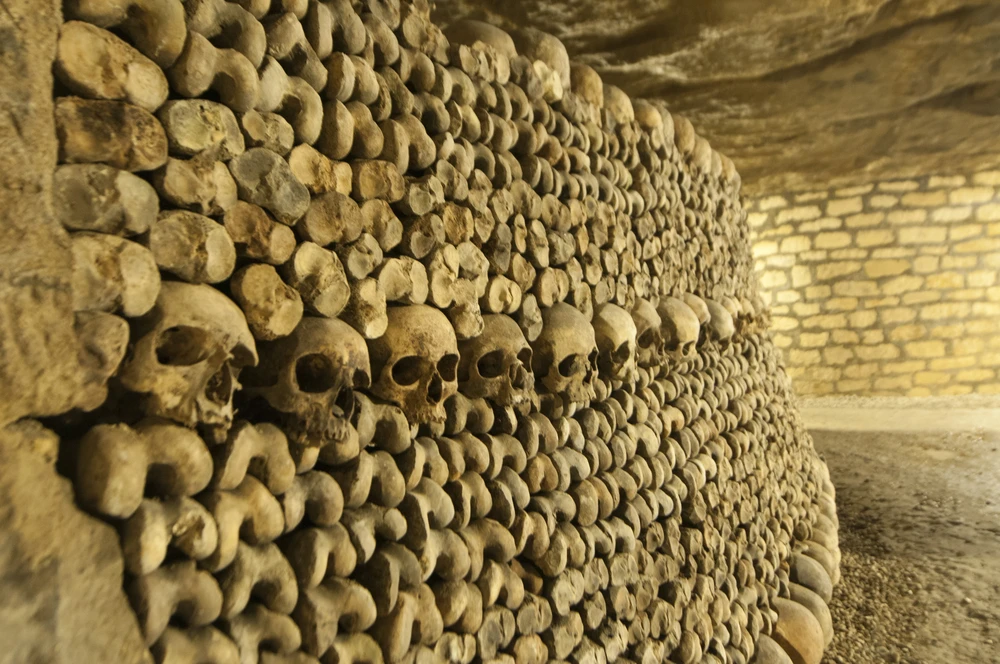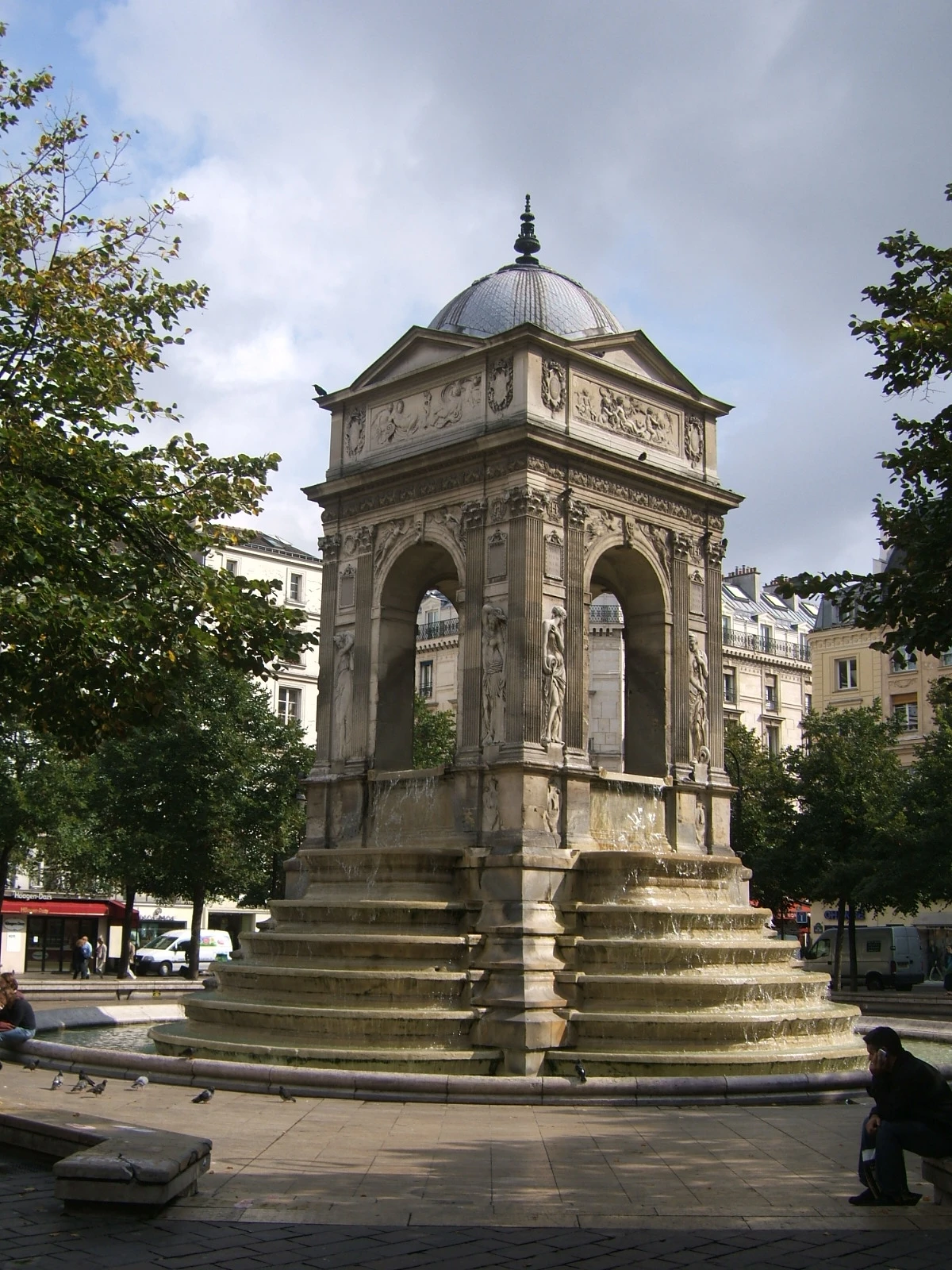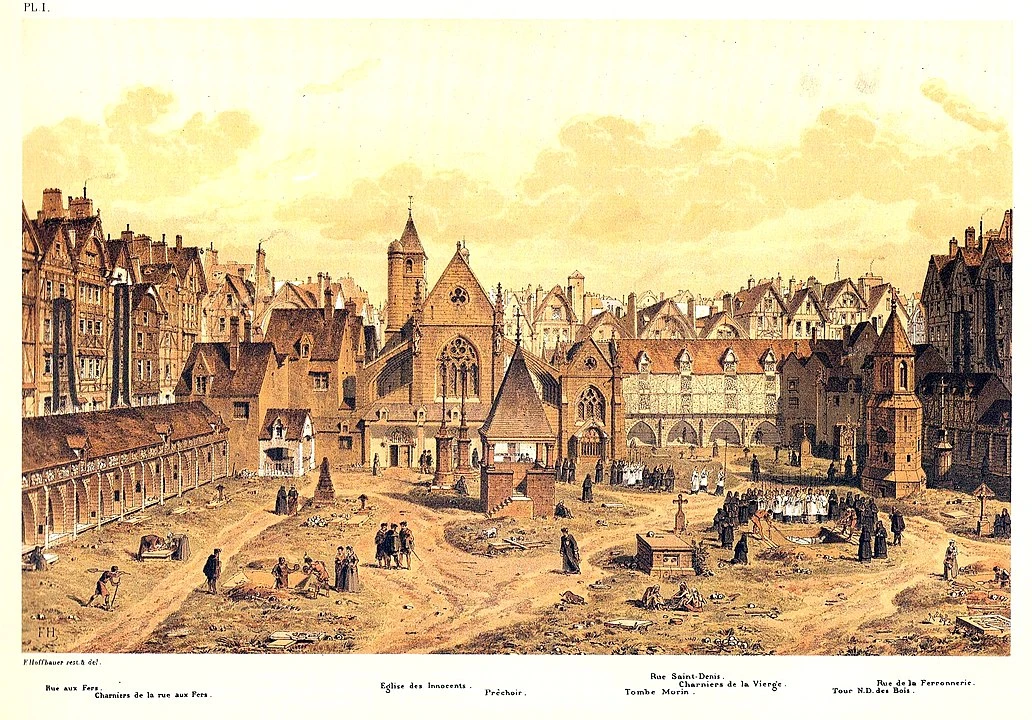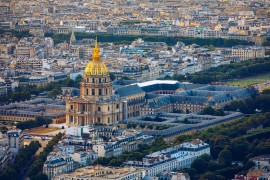There may be translation errors. Our translator wanted to visit the catacombs outside the official visiting zone and got lost. We may never find him again...
What are catacombs?
For centuries, as far back as Roman times in fact, the soil of Paris has been dug to extract stone for the city's main monuments . The stones for Notre Dame de Paris and the Louvre, for example, come from these quarries. Over time, kilometers of multi-level galleries were dug beneath the French capital. The total length of these galleries beneath Paris is estimated at over 300 kilometers, and their depth at around 20 meters below ground level. Some of them were destroyed when the Paris Metro was built at the end of the 19th century. Some of these quarries were destroyed for safety reasons. Others still exist. The famous Paris mushrooms have long been grown here. In 1885, there were 300 growers, producing 1,000 tons of mushrooms a day. Today, 6 of them continue the tradition.
The world's largest ossuary
And, from the end of the 18th century until 1861, part of them was used to store the bones of millions of Parisians who had died over the centuries when the Parisian cemeteries were closed, including the largest and most famous of them all, the Cimetière des Innocents. Today, the visible part of the catacombs is just over a kilometer long.
The remains of almost 6,000,000 people are carefully stored in the catacombs of Paris. Photo: dépositphotos.com
What can you visit?
To enter the catacombs, you have to climb down a hundred or so steps, covering 1.7 km of gallery for a total of 11,000 M2 . Beware, the ceilings are low! 1m80 maximum. The temperature is always the same: 14.5°C. Above all, don't visit any part other than the "official" one. Every year, the Paris fire department rescues curious visitors lost in the catacombs. Remember: there are 300 km of galleries...
We see hundreds of thousands of bones, neatly arranged. Skulls together, tibias together, and in rows. The site is decorated with columns carved in stone. There are a few funerary monuments , such as ancient or Egyptian-inspired tombs. There are also place names to help you find your way around, such as "the sarcophagus of the lachrymatorium" or "the Samaritan fountain". There are also a few "cabinets of curiosities" devoted to a specific theme, such as mineralogy or medical curiosities like original bones. Viscount Louis-Etienne Héricart de Thury (1776-1854) was responsible for creating the catacombs as we know them today. It was he who wanted to set up a tour, sculptures and science before opening the site to the public in 1809.
Décure's work.
Décure, a soldier from the late 18th century, employed as a quarryman in the catacombs, also left some sculpted works. Fascinated by the place, and by art, this former soldier spent several years carving stone to decorate the place. If you're Spanish, you'll discover the citadel of Port Mahon, in the Balearic Islands, where Décure took part in its siege in 1756. Very precise and meticulous, he also decorated the floor with black flint stones. His passion ultimately cost him his life , as he was buried in 1782 while digging a staircase to his works. The ceiling collapsed.
We come across monuments and even signs with thought-provoking phrases, such as this one from the Aeneid. Photo chosen by monsieurdefrance.com: By Deror avi - Own work, CC BY-SA 3.0, https://commons.wikimedia.org/w/index.php?curid=6085673
A place for science in the 19th century
The catacombs have been used for numerous experiments. In 1813, Louis-Etienne Héricart de Thury (1776-1854) experimented with launching fish into this pitch-black world. They became blind (and did not reproduce, so there are no fish in the catacombs). The site was also used by speleologists, with Armand Viré (1869-1951) revealing the existence of crustaceans in the waters of the catacombs. Jacques Maheu (1873-1937), an important botanist, studied the flora of caves and the night. In 1861, Nadar (1820-1920) worked on night photography with artificial light. Since exposure times were very long in the mid-nineteenth century, he was obliged to use mannequins to represent the workers.
Millions of bones, including those of
We know that among the bones in the catacombs are those of many of France's most famous historical figures. The sepulchres having been destroyed, their bones have joined the bones of millions of other anonymous figures. So, without recognizing them, you'll probably come across the bones of writer François Rabelais (1494-1553), Jean de la Fontaine (1621-1695), author of the fables that bear his name, or Charles Perrault (1628-1703), author of the famous Perrault fairy tales. This is also the resting place of Jules Hardoüin-Mansart (1646-1708), architect of Versailles, and Salomon de Brosse (1571-1626), architect of the Palais du Luxembourg and the Parlement de Bretagne in Rennes. It is also where the remains of many revolutionaries are buried, including Danton (1759-1794), Camille Desmoulins (1760-1794) and Robespierre (1758-1794).
The origin of the catacombs: the cemetery of the innocent.
A very old cemetery
The catacombs were created in 1786. Why were they created? Becausethe notorious cemetery of the innocent had to be emptied. Paris' largest cemetery was literally overflowing. The dead from 22 Parisian parishes were buried there - in other words, the entire center of Paris. Then there were the plague victims, the drowned and the anonymous dead. An estimated 2 million Parisians were buried there. It was on May 7, 1780, when the wall of a nearby cellar collapsed under the weight of the cemetery's bones, that the authorities decided to close this burial site dating back to Merovingian times (8th-9th centuries), and which had served as a burial ground for Parisians for 1,000 years. Bordering rue Saint Denis and the church of Saint Innocents, which gave it its name, it was dedicated to the victims of King Herod when he decided to have all Jewish first-borns killed after learning from the Magi that a king had been born on Christmas Eve. It disappeared in 1786, when the cemetery was evacuated and destroyed to make way for a ... place, which for a long time was the innocents' market square, before the Halles were built, and which today is called Place Joachim du Bellay. It features the famous Fountain of the Innocents, built in 1559 at the behest of King Henri II of France by architect Pierre Lescot (1515-1578) and sculpted by Jean Goujeon (1510-1567).
the Fountain of the Innocents today. Photo chosen by monsieurdefrance: Kmlz on en.wikipedia, CC BY-SA 2.5 <https://creativecommons.org/licenses/by-sa/2.5>, via Wikimedia Commons
A very special cemetery
Buried here were the dead of France's largest city, and one of Europe's largest (2nd only to London), so the cemetery was packed to the rafters . Seventeenth-century Parisians claimed that the soil in the Cemetery of the Innocents could dissolve a body in 9 days. The surrounding water was contaminated, and it's even said that the air in the cellars around the cemetery was so foul that candles went out by themselves. The rich were buried in individual graves in the center of the cemetery, in wooden coffins, while the very rich were buried in the church. For the poor, the sides, mass graves and a shroud. With so much burial, the cemetery floor ended up several meters higher than the surrounding pavements, even if some pits were periodically emptied to store the bones in a charnel house on the side (financed by Nicolas FLAMEL, the famous alchemist). A danse macabre adorned the walls. That said, as Paris is an amazing city, and space has been in short supply for centuries, many of the pits were occupied not only by bones, but also by fashion boutiques in the 17th century.
The cemetery of the innocent in Paris in the 17th century. Illustration chosen by monsieurdefrance.com: By Theodor Josef Hubert Hoffbauer - Own work, scan by Jebulon, Public domain Wikicommons
The Cemetery of the Innocents was also famous for its two reclusoirs, in which religious hermits shut themselves away from the world. In these stone cels, with a single opening consisting of a window and its grate, the recluses were walled up alive, most of them in their entirety. One woman, however, was condemned to be locked up rather than burned alive for adultery and having her husband murdered. The recluses were provided with food by donations from passers-by through the window, and remained there until death.
Where are the catacombs of Paris?
how to get there :
Address:
1 Avenue du Colonel Rol-Tanguy, 75 014 PARIS
RER :
Line B Denfert-Rochereau station
Metro :
Lines 4 and 6 Denfert-Rochereau station
BUS :
38 / 59 / 64 / 68 / 88
Parking :
83 Boulevard Saint-Jacques (paying).
Timetables
Tuesday to Sunday : 9H45 - 20H30 except special evenings. Closed on Mondays, January 1, May 1 and December 25.
Official website:
For up-to-date information and opening hours, visit the official catacombs website .
Prices :
Honestly, it's quite expensive, since for the same price you can visit the Louvre or Versailles. Please note that what I'm giving you here are the 2023 prices. To be sure of the rates, consult the official website. You'll need to book in advance, as on-the-spot sales are not always possible due to overcrowding.
Full price: 29 euros (with audioguide).
Reduced rate (including 18-25 year-olds, students...): 23 euros (with audioguide).
Children (aged 5 to 17): 10 euros.
Please note that there are no lockers or luggage storage.








